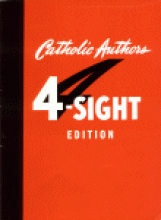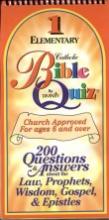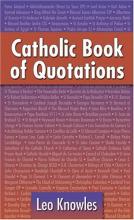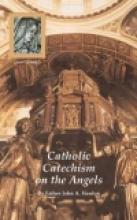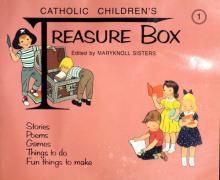No name
Catholic Authors - 4 Sight Edition
This book was designed for grades 7 through 9 to give "a vital, illustrated presentation of Catholic literature to help students 'see' and love Christ four ways always: in Himself, in Others, in His Creation, in His Mother." [from the back cover]
The author does this by first explaining how God is visible to us: In Himself (Seeing God: "Love the Lord thy God"), In Others ("Love thy Neighbor"), In Creation ("Consider the Lilies") and In His Mother ("Behold thy Mother"). The book reviews and brief author and illustrator biographies are broken up into these four categories. We are introduced to great authors of the past and present (at least as of 1949!) who have illustrated these concepts to us by use of real characters, action and life situations.The reviews themselves are rather brief - they really amount to short "teasers" - an attempt to interest students in reading these books. There are also a number of brief essays which elaborate on how some of the individual books teach us about God, even if indirectly. Although Catholic Authors was designed for students, I think it should be required reading for homeschooling parents. Its value is two-fold for us: 1. A source of information about good reading for our children (although many of the books are out of print, others are available new from companies such as Bethlehem Books, TAN and Neumann Press). 2. An education for parents (without a huge amount of reading) in the importance of literature, and especially Catholic literature, in our children's education and spiritual formation.
Catholic Bible Quiz: Elementary Level
This book provides 200 questions and answers - forty each in five different categories - the Law, the Prophets, Wisdom, the Gospel and the Epistles. The book is designed to be used as a quiz game - keeping score (based on the difficulty of the questions - each question is awarded a particular point value) to determine the winner. It could just as easily be used as an informal reinforcement of Bible Study. It is very similar in format to the New Catholic Quiz listed above.
Sample Questions from this book: (page one) What is the first book of the Bible? Who was the pagan God of the Canaanites? (a. Dracula, b. Beelzebul, C. Baal) What book of the Bible has the shortest title? To whom was Joseph engaged to be married? (a. Martha, b. Mary, c. Elizabeth How many days did Jesus continue to appear to his apostles after the resurrection? (a. sixty, b. forty, c. fifty)
Imprimatur
Catholic Bible Stories for Children
Catholic Book of Quotations
This inexpensive paperback offers a wide variety of memorable Catholic quotations from both ancient and modern sources. The book is organized according to subject. Here are just a few: Abortion, Art, Baptism, Blessed Sacrament, Conscience, Devil, Divine Mercy, Dying Words, Family, Fasting, Free Will, Generosity, Grace, Guardian Angel, Incarnation, Justice, Marriage, Our Lady, Prayer, Priesthood, Rosary, Sin, Suffering, Transubstantiation, Virtue and Vocation. Authors quoted in this work include: St. Augustine, Pope John Paul II, Msgr. Robert Hugh Benson, St. Josemaria Escriva, St. Thomas Aquinas, St. John of the Cross, G. K. Chesterton, Charles Péguy, St. Ignatius Loyola and St. Padre Pio. There are a few authors that might raise a few eyebrows, but I didn't find anything off-base. I've really enjoyed having this around the house to find some inspiration, highlight an idea when writing to someone or complete a special project (I just made a plaque for my daughter's room with a quote from St. Francis that I found in this book).
Catholic Bookmark Kit from Illuminated Ink
Catholic Cardlinks: Bible
Catholic Cardlinks: Patron Saints
Children will love (I speak from experience with my own brood) to befriend the saints with this charming resource that they can so easily hold in their little hands. Each elongated cardstock sheet has a colorful sketch of a saint (48 saints in all) with a short biography. The pages fan out so that you can see all of the faces at once. Or open to one at a time and spend a little time reading about your favorites. When I leave this sort of book laying in reach of my little ones (especially the pre-readers), they will become acquainted with the pictures over time and find their favorites that they ask me to read about over and over. What a nice way to help young children develop a devotion to a favorite saint!
I'm also delighted to see such colorful and creative resources being published for young children.
Binding details: cardstock pages pivot on a sturdy post
Catholic Catechism on the Angels
In today's culture, angels are represented on everything from popular television programs to needlecraft projects, but they are rarely portrayed accurately. This little powerhouse of a book sets the record straight on Catholic teaching regarding our "holy helpers". Thorough but concise, it is written for upper high-school students and adults.
The book is organized into three sections that take the form of a brief essay followed by a question-and-answer catechism clarifying each point made. Father Hardon begins with a study of the angels, providing an explanation of angelic terms and definitions commonly used in reference to angels; adversaries, which are those individuals or systems which deny the doctrines about angels; and doctrinal value, which refers to the need for a believing Catholic to accept what is taught by the Church. He continues with the Catholic doctrines on the existence of angels from three different directions: ecclesiastical authority, sacred scripture, and theological reasoning. Finally, Father Hardon concludes with the proofs that angels are pure spirits from ecclesiastical authority, sacred scripture and tradition, and patristic evidence.
Imprimatur and Nihil Obstat
Catholic Children's Treasure Box
This set of colorful books for ages 3-8 are reprints of a Catholic magazine from the 1950s. They are filled with stories, games, picture puzzles, poems, crafts, etc. The pictures are beautiful and I like the very simple moral lessons many of the stories teach. (For example, when my daughter was three, she was very impressed by a story called "Peter the Picky Eater". Her eating habits changed and she honestly admitted that she wished I hadn't read it to her.) There are currently 20 volumes in print out of more than 60 that were originally published (unfortunately it may take quite awhile to find out what happens to Wupsy in the end!).
We have especially enjoyed the St. Therese stories from the first few volumes. These have been a favorite mostly among the preschool set in our family. While many Catholic homeschool parents treasure these books, there are two complaints that I've heard from a number of parents. First, some parents have bought the set thinking they would be nice for early grade school and found them to be more appropriate for preschool (as read-alouds). Second, the pedagogy at times doesn't hold up to serious scrutiny. Complaints include the sappy way in which the devil is presented in the Wupsy stories and the "self-righteous" expressions on some of the faces in the illustrations.

